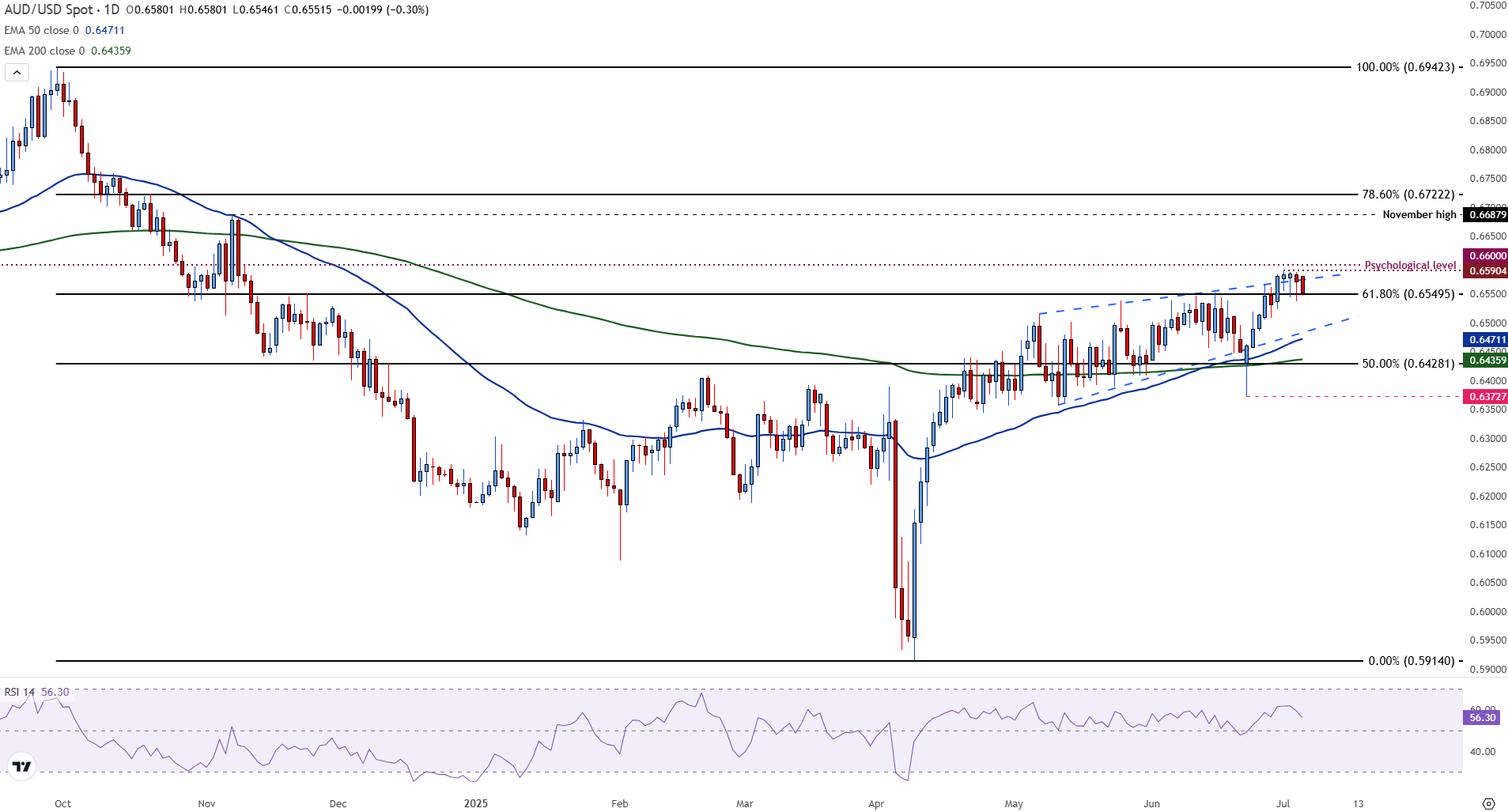
- AUD/USD retreats amid renewed demand for safe havens ahead of Trump’s tariff deadline.
- AUD pressured by RBA cut expectations, while steady Fed policy underpins USD.
- AUD/USD holds a bullish structure, though momentum fades near wedge resistance.
The Australian Dollar (AUD) weakened against the US Dollar (USD) on Friday amid a low-volume trading session and a risk-off tone ahead of US President Donald Trump’s July 9 tariff deadline.
At the time of writing, AUD/USD is hovering above 0.6550, with intraday losses of 0.30%.
The closure of US financial markets for Independence Day led to lighter trading volumes, resulting in subdued volatility and a more corrective tone across currency markets.
Adding to the bearish bias was weaker-than-expected Australian trade data. Figures released on Thursday showed a 2.7% decline in exports for May, resulting in a narrower trade surplus.
A risk-off tone was visible on Friday ahead of President Trump’s July 9 tariff deadline.
Trump’s threat to impose tariffs of 10% to 70% on multiple countries and dictate trade terms has reignited global trade fears, prompting safe-haven flows and pressuring risk-sensitive currencies.
At the same time, expectations are mounting that the Reserve Bank of Australia (RBA) will continue easing monetary policy.
According to a Reuters survey released on Friday, a strong majority of 31 out of 37 economists expect the central bank to implement a third consecutive 25-basis-point rate cut on Tuesday. This would bring the official cash rate down to 3.60%.
This anticipated move reflects the RBA’s response to moderating inflation and a slowing domestic economy. Meanwhile, the Federal Reserve (Fed) has maintained interest rates within the 4.25% to 4.50% range, providing some support to the US Dollar.
AUD/USD technical levels to watch
From a technical perspective, AUD/USD remains within the confines of a rising wedge pattern on the daily chart, a structure that often signals potential trend exhaustion. Recent price action has struggled to breach the 0.6590 level, with multiple failed attempts to clear this barrier just beneath the key psychological resistance at 0.6600. This hesitation has led to a mild pullback, reflecting market indecision as bullish momentum starts to fade.
Despite the pullback, the broader trend remains constructive. The pair continues to trade above both the 50-day Exponential Moving Average (EMA), currently at 0.6471, and the 200-day EMA at 0.6436. This highlights the underlying bullish structure and suggests that buyers remain in control on a medium-term basis.
AUD/USD daily chart

Momentum indicators, however, are starting to show early signs of fatigue. The Relative Strength Index (RSI) has eased to around 56, down from prior highs, indicating weakening momentum while still holding above the neutral 50 level. This suggests that the bullish bias is still intact, but momentum is softening.
A confirmed breakout above 0.6600 could trigger renewed upside, potentially opening the door to the 78.6% Fibonacci retracement of the September–April decline at 0.6722.
On the downside, a rejection at current levels may lead to a deeper pullback, with initial support seen at the 61.8% Fibonacci level near 0.6550. This may be followed by stronger support near the 50% retracement at 0.6428, which closely aligns with the 200-day EMA, adding to its technical significance.
Risk sentiment FAQs
In the world of financial jargon the two widely used terms “risk-on” and “risk off” refer to the level of risk that investors are willing to stomach during the period referenced. In a “risk-on” market, investors are optimistic about the future and more willing to buy risky assets. In a “risk-off” market investors start to ‘play it safe’ because they are worried about the future, and therefore buy less risky assets that are more certain of bringing a return, even if it is relatively modest.
Typically, during periods of “risk-on”, stock markets will rise, most commodities – except Gold – will also gain in value, since they benefit from a positive growth outlook. The currencies of nations that are heavy commodity exporters strengthen because of increased demand, and Cryptocurrencies rise. In a “risk-off” market, Bonds go up – especially major government Bonds – Gold shines, and safe-haven currencies such as the Japanese Yen, Swiss Franc and US Dollar all benefit.
The Australian Dollar (AUD), the Canadian Dollar (CAD), the New Zealand Dollar (NZD) and minor FX like the Ruble (RUB) and the South African Rand (ZAR), all tend to rise in markets that are “risk-on”. This is because the economies of these currencies are heavily reliant on commodity exports for growth, and commodities tend to rise in price during risk-on periods. This is because investors foresee greater demand for raw materials in the future due to heightened economic activity.
The major currencies that tend to rise during periods of “risk-off” are the US Dollar (USD), the Japanese Yen (JPY) and the Swiss Franc (CHF). The US Dollar, because it is the world’s reserve currency, and because in times of crisis investors buy US government debt, which is seen as safe because the largest economy in the world is unlikely to default. The Yen, from increased demand for Japanese government bonds, because a high proportion are held by domestic investors who are unlikely to dump them – even in a crisis. The Swiss Franc, because strict Swiss banking laws offer investors enhanced capital protection.
Information on these pages contains forward-looking statements that involve risks and uncertainties. Markets and instruments profiled on this page are for informational purposes only and should not in any way come across as a recommendation to buy or sell in these assets. You should do your own thorough research before making any investment decisions. FXStreet does not in any way guarantee that this information is free from mistakes, errors, or material misstatements. It also does not guarantee that this information is of a timely nature. Investing in Open Markets involves a great deal of risk, including the loss of all or a portion of your investment, as well as emotional distress. All risks, losses and costs associated with investing, including total loss of principal, are your responsibility. The views and opinions expressed in this article are those of the authors and do not necessarily reflect the official policy or position of FXStreet nor its advertisers. The author will not be held responsible for information that is found at the end of links posted on this page.
If not otherwise explicitly mentioned in the body of the article, at the time of writing, the author has no position in any stock mentioned in this article and no business relationship with any company mentioned. The author has not received compensation for writing this article, other than from FXStreet.
FXStreet and the author do not provide personalized recommendations. The author makes no representations as to the accuracy, completeness, or suitability of this information. FXStreet and the author will not be liable for any errors, omissions or any losses, injuries or damages arising from this information and its display or use. Errors and omissions excepted.
The author and FXStreet are not registered investment advisors and nothing in this article is intended to be investment advice.







